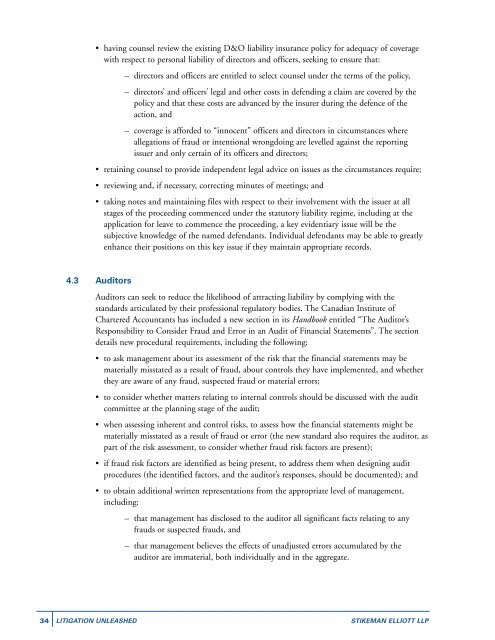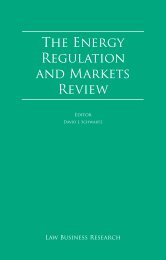LITIGATION UNLEASHED - Stikeman Elliott
LITIGATION UNLEASHED - Stikeman Elliott
LITIGATION UNLEASHED - Stikeman Elliott
Create successful ePaper yourself
Turn your PDF publications into a flip-book with our unique Google optimized e-Paper software.
• having counsel review the existing D&O liability insurance policy for adequacy of coverage<br />
with respect to personal liability of directors and officers, seeking to ensure that:<br />
– directors and officers are entitled to select counsel under the terms of the policy,<br />
– directors’ and officers’ legal and other costs in defending a claim are covered by the<br />
policy and that these costs are advanced by the insurer during the defence of the<br />
action, and<br />
– coverage is afforded to “innocent” officers and directors in circumstances where<br />
allegations of fraud or intentional wrongdoing are levelled against the reporting<br />
issuer and only certain of its officers and directors;<br />
• retaining counsel to provide independent legal advice on issues as the circumstances require;<br />
• reviewing and, if necessary, correcting minutes of meetings; and<br />
• taking notes and maintaining files with respect to their involvement with the issuer at all<br />
stages of the proceeding commenced under the statutory liability regime, including at the<br />
application for leave to commence the proceeding, a key evidentiary issue will be the<br />
subjective knowledge of the named defendants. Individual defendants may be able to greatly<br />
enhance their positions on this key issue if they maintain appropriate records.<br />
4.3 Auditors<br />
Auditors can seek to reduce the likelihood of attracting liability by complying with the<br />
standards articulated by their professional regulatory bodies. The Canadian Institute of<br />
Chartered Accountants has included a new section in its Handbook entitled “The Auditor’s<br />
Responsibility to Consider Fraud and Error in an Audit of Financial Statements”. The section<br />
details new procedural requirements, including the following:<br />
• to ask management about its assessment of the risk that the financial statements may be<br />
materially misstated as a result of fraud, about controls they have implemented, and whether<br />
they are aware of any fraud, suspected fraud or material errors;<br />
• to consider whether matters relating to internal controls should be discussed with the audit<br />
committee at the planning stage of the audit;<br />
• when assessing inherent and control risks, to assess how the financial statements might be<br />
materially misstated as a result of fraud or error (the new standard also requires the auditor, as<br />
part of the risk assessment, to consider whether fraud risk factors are present);<br />
• if fraud risk factors are identified as being present, to address them when designing audit<br />
procedures (the identified factors, and the auditor’s responses, should be documented); and<br />
• to obtain additional written representations from the appropriate level of management,<br />
including:<br />
– that management has disclosed to the auditor all significant facts relating to any<br />
frauds or suspected frauds, and<br />
– that management believes the effects of unadjusted errors accumulated by the<br />
auditor are immaterial, both individually and in the aggregate.<br />
34 <strong>LITIGATION</strong> <strong>UNLEASHED</strong> STIKEMAN ELLIOTT LLP
















